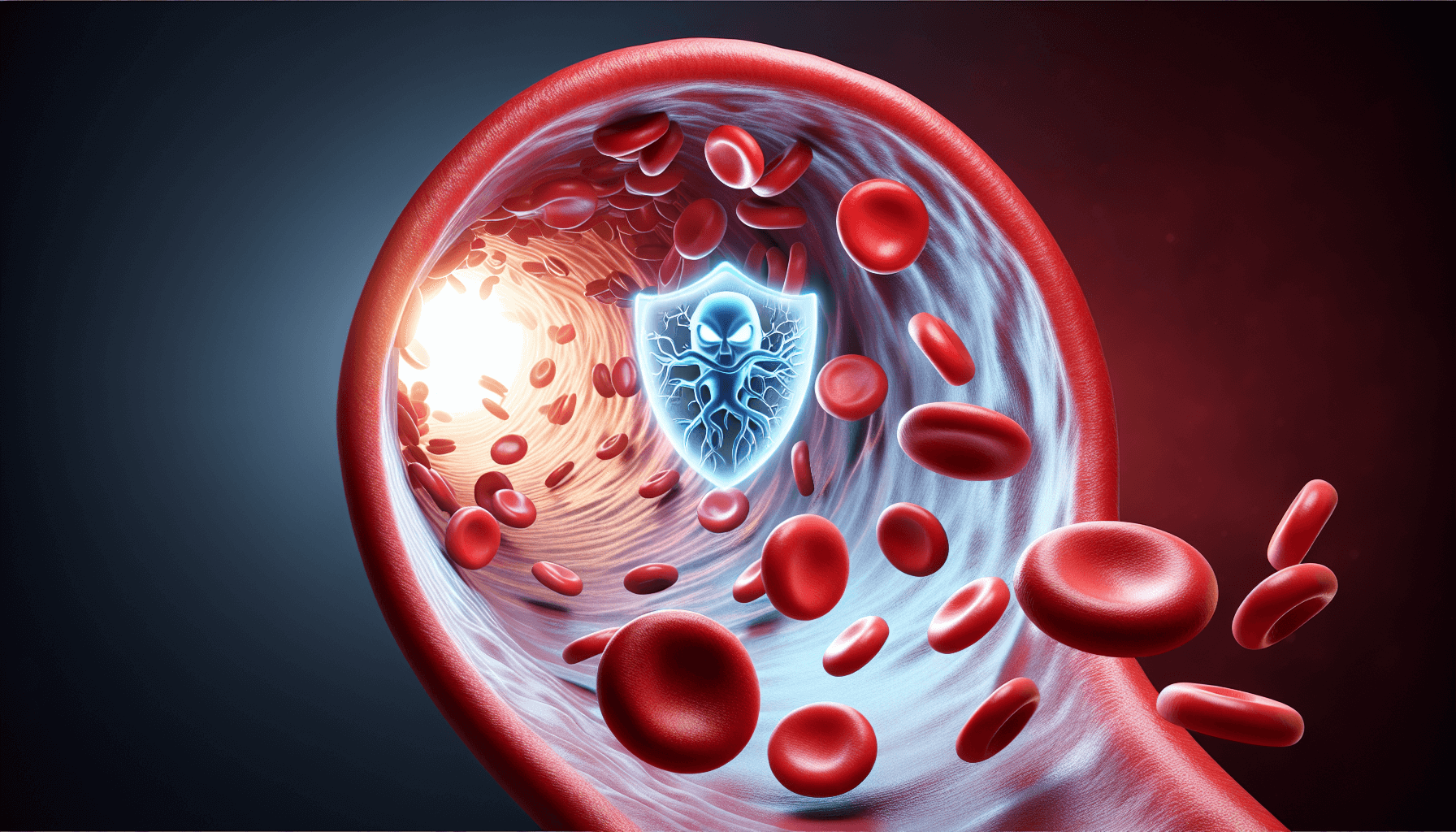Concerned about Xarelto side effects? Key effects include bleeding episodes and serious allergic responses. We’ll navigate these concerns, guide you on monitoring symptoms, and find out when it’s critical to consult your healthcare provider.
Key Takeaways
- Xarelto is an anticoagulant with potential side effects, such as bleeding and gastrointestinal symptoms, which require monitoring and immediate medical attention in severe cases.
- Patients should consult with healthcare providers before making any changes to their Xarelto treatment, including its discontinuation, due to the risks of increased blood clot formation and stroke.
- Xarelto interacts with various medications and health conditions, and is contraindicated in certain populations, including pregnant and breastfeeding women, as well as patients with significant liver or kidney impairments.
Understanding Xarelto and Its Role in Preventing Blood Clots
Xarelto, also known as rivaroxaban, helps prevent the formation of dangerous blood clots. It’s commonly used to:
- Reduce the risk of stroke and blood clots in people with nonvalvular atrial fibrillation
- Reduce the risk of pulmonary embolism and deep venous thrombosis
This blood thinner medicine works its by inhibiting Factor Xa, a crucial enzyme in the coagulation process responsible for the formation of blood clots, ultimately helping to treat blood clots and prevent future blood clots.
In this article, I will focus on major side effects of Xarelto, but it is important to also point out the benefits of this medication as discussed below.
Benefits of Xarelto: Clinical Trials and Results
Xarelto, with its active ingredient rivaroxaban, has been extensively studied in clinical trials and has shown to be beneficial for various conditions associated with blood clots. The medication’s efficacy is grounded in its ability to selectively inhibit Factor Xa, an important enzyme in the blood coagulation process, which plays a pivotal role in thrombin generation and blood clot formation.
Key Clinical Trials and Their Findings
ROCKET AF Trial
One of the landmark studies, the ROCKET AF trial, demonstrated the benefits of Xarelto in reducing the risk of stroke in patients with nonvalvular atrial fibrillation. In this study, Xarelto was found to be non-inferior to warfarin, a traditional anticoagulant, in preventing stroke or systemic embolism. The trial also highlighted Xarelto’s favorable safety profile, with similar rates of major bleeding as compared to warfarin.
EINSTEIN DVT/PE Trials
The EINSTEIN DVT and EINSTEIN PE trials evaluated the use of Xarelto for the treatment and secondary prevention of deep vein thrombosis and pulmonary embolism. Results from these trials indicated that Xarelto was as effective as the standard treatment of enoxaparin followed by a vitamin K antagonist, with a comparable safety profile.
COMPASS Trial
The COMPASS trial further established the benefits of Xarelto in the prevention of major cardiovascular events in patients with chronic coronary artery disease or peripheral artery disease. Xarelto, used in combination with aspirin, significantly reduced the risk of stroke, myocardial infarction, and cardiovascular death, marking a notable advancement in the management of these conditions.
Major Results and Their Impact on Patient Care
The results from these trials have had a profound impact on the management of thromboembolic disorders. Xarelto offers the convenience of oral administration without the need for routine blood monitoring, a significant advantage over traditional anticoagulants like warfarin. This ease of use, combined with its proven efficacy, makes Xarelto an important option for patients requiring long-term anticoagulation.
Additionally, the predictability of Xarelto’s anticoagulant effect allows for a fixed-dose regimen without dose adjustments, which simplifies treatment protocols and enhances patient adherence to therapy.
Recognizing Common Xarelto Side Effects
Common side effects of Xarelto can include:
- Back pain
- Bleeding gums
- Bloody stools
- Prolonged bleeding from cuts
- Red or dark brown urine
- Significant bruising
The symptoms of Xarelto side effects may include unusual bleeding, unusual tiredness, and significant bruising tendencies. It is important to consult a healthcare professional if you experience any of these symptoms while taking Xarelto.
Excessive fatigue or shortness of breath can also be a concerning symptoms, potentially necessitating consultation with a healthcare provider, as it can be a sign of subclinical bleeding or anemia.
Bleeding Complications
The risk of bleeding is a significant concern for Xarelto users. Symptoms of unusual bleeding may include:
- prolonged bleeding
- unexpected bleeding from the gums
- black or tarry stools
- coughing up blood or blood clots
- blood in urine
Severe, unexpected, or uncontrollable bleeding, including frequent nosebleeds or heavier than normal menstrual or vaginal bleeding, necessitates prompt medical attention, especially if accompanied by dark brown urine vomiting or vaginal bleeding leg weakness.
For those using Xarelto on a long-term basis, maintaining alertness is vital to detect signs of internal bleeding. Unusual bruising, prolonged bleeding from cuts, and increased menstrual flow or blood in the urine or stools can be indicators of internal bleeding. Furthermore, symptoms like a severe headache, dizziness, or weakness may point to bleeding in the brain, requiring immediate consultation with a healthcare provider.
Rates of Major Bleeding from Xarelto
Clinical trials have provided essential data on the rates of major bleeding events associated with Xarelto. In the ROCKET AF trial, which compared Xarelto to warfarin in patients with atrial fibrillation, the annual rate of major bleeding was 3.6% for those on Xarelto versus 3.4% for warfarin. Another significant study, the EINSTEIN DVT/PE trials, reported major bleeding in 1.7% of patients treated with Xarelto compared to 1.5% with the standard therapy of enoxaparin followed by a vitamin K antagonist (usually warfarin). It’s noteworthy that bleeding rates can vary depending on the patient’s condition, dosage, and duration of treatment with Xarelto. These trials underscore the importance of careful monitoring and adherence to prescribed dosages to mitigate the risks of major bleeding events.
Gastrointestinal Symptoms
Abdominal discomfort can be another side effect related to Xarelto usage. Abdominal pain was noted as a common side effect during Xarelto’s clinical trials. Patients experiencing abdominal pain whilst on Xarelto should promptly reach out to their doctor to discuss the symptoms.
Timely communication with healthcare professionals can help manage these symptoms and mitigate potential health risks.
Severe Reactions to Xarelto
Despite its benefits in preventing and treating blood clots, Xarelto can sometimes trigger severe reactions. Major bleeding events such as cerebral hemorrhage and gastrointestinal bleeding are serious, potentially fatal reactions to Xarelto. Symptoms such as a sudden severe headache, confusion, difficulty speaking, or vision changes may signal a stroke or intracranial bleeding and demand immediate medical attention.
Allergic reactions could manifest as painful urination, cough, dark urine, diarrhea, blistering skin, skin rash, hoarseness, joint pain, red skin lesions, or chest tightness, indicating the need to contact a healthcare provider.
Urgent Medical Symptoms
Some symptoms associated with Xarelto usage require urgent medical attention. Severe headache, dizziness, weakness, or fainting are critical symptoms that should not be overlooked. Symptoms of a serious bleeding event such as coughing up blood, difficulty breathing or swallowing, and sudden changes in wound sites after surgery are also urgent signs that warrant immediate medical consultation.
Symptoms like back pain, bleeding gums, bloody stools, or bowel or bladder dysfunction should be promptly communicated to healthcare providers. Severe drop in blood pressure, rapid pulse, accompanied by dizziness or lightheadedness may indicate an anaphylactic allergic reaction.
Signs of Allergic Reaction
Allergic reactions to Xarelto can range from mild to severe. Mild reactions may include itching, skin rash, severe headache, sore throat, and flushing. Severe reactions, on the other hand, are characterized by symptoms such as skin rash, itchiness, swelling under the skin typically in the lips, eyelids, feet, or hands, and swelling of the mouth, tongue, or throat which can make it hard to breathe.
If mild symptoms of an allergic reaction to Xarelto, such as rash, itching or flushing, are experienced, contacting your doctor immediately is advised.
The Risk of Discontinuing Xarelto
The discontinuation of Xarelto treatment should be a decision made carefully and in consultation with a healthcare provider. Abrupt discontinuation of Xarelto can lead to an increased risk of forming a blood clot or even experiencing a stroke. In some cases, these risks can have fatal outcomes.
Withdrawal symptoms from Xarelto may include:
- headache
- fatigue
- dizziness
- lightheadedness
- easy bruising
- back pain
- nausea
- heart palpitations
- high blood pressure
- leg weakness
- emotional disturbances such as depression, restlessness, and sleep difficulties
As such, healthcare providers usually recommend a gradual tapering off under medical supervision to minimize withdrawal symptoms and reduce the risks of abrupt cessation.
Xarelto Reversal Agent for Severe Bleeding
In the event of severe bleeding complications or the need for emergency surgery, it’s crucial to manage the effects of Xarelto promptly. Andexanet alfa (brand name Andexxa®) has been approved by the FDA as a reversal agent for rivaroxaban, the active ingredient in Xarelto. This medication acts as a decoy receptor, binding to rivaroxaban and neutralizing its anticoagulant effects, thereby reducing the risk of uncontrolled bleeding.
It’s important to note that Andexanet alfa should only be used in life-threatening or uncontrolled bleeding situations where the benefits of reversing the effects of Xarelto outweigh the risk of potential thromboembolic events. The administration of this reversal agent requires careful monitoring in a medical facility by healthcare professionals experienced in the treatment of bleeding associated with anticoagulation.
In addition to Andexanet alfa, other supportive measures may be employed such as the transfusion of fresh frozen plasma or the administration of vitamin K, although their efficacy with direct Factor Xa inhibitors like rivaroxaban is limited. Patients and caregivers should be aware of the availability of these reversal strategies and should consult with healthcare providers for the best course of action in the case of severe bleeding.
Interactions and Contraindications
With Xarelto, it’s not merely about the medication itself, but it’s also about its interactions with other medications and health conditions. Xarelto is contraindicated for patients with acute or chronic liver disease when accompanied by coagulopathy that leads to an increased bleeding risk. Similarly, patients with active bleeding conditions should not use Xarelto due to its blood-thinning effects which could exacerbate bleeding.
Medication Interactions
Other medications can interact with Xarelto, potentially leading to adverse effects. The concurrent use of Xarelto and frequent use of nonsteroidal anti-inflammatory drugs (NSAIDs) may increase the risk of bleeding, thus healthcare providers typically recommend avoiding this combination. Moreover, drugs that are strong inhibitors of both CYP3A4, such as certain azole antifungals and HIV protease inhibitors, can significantly increase plasma levels of rivaroxaban and heighten bleeding risks.
Certain antiepileptic drugs can reduce the effectiveness of Xarelto by affecting its metabolism, which may necessitate changes to the prescribed treatment.
Interactions of Alcohol with Xarelto: Risk for Increased Bleeding
Consuming alcohol while taking Xarelto can pose significant health risks, particularly an increased likelihood of bleeding complications. Alcohol has a natural blood-thinning effect, which, when combined with Xarelto, can amplify this property and potentially lead to excessive bleeding. Patients are often advised to limit or avoid alcohol intake to reduce the risk of adverse effects.
Heavy or chronic alcohol use can also damage the liver, which is responsible for metabolizing Xarelto. Compromised liver function can lead to higher levels of the drug in the bloodstream, further increasing the risk of bleeding. Additionally, alcohol consumption can exacerbate the side effects of Xarelto, such as dizziness and lightheadedness, which can increase the risk of falls and related injuries.
Healthcare providers typically recommend that patients on Xarelto discuss their alcohol use to ensure safe management of their medication and condition. In cases where alcohol consumption cannot be avoided, it is crucial to consume it in moderation and under the guidance of a healthcare professional.
Health Conditions and Xarelto
Certain health conditions can also affect Xarelto usage. Liver damage and hepatitis have been reported post-marketing in patients taking Xarelto, although these were not observed during the clinical trials. Individuals with moderate to severe liver impairment may not be able to properly process Xarelto, increasing the risk of side effects.
Patients with kidney problems may have a reduced capacity to break down Xarelto, potentially leading to drug accumulation and an elevated risk of adverse effects. Those with reduced kidney function should be cautious with Xarelto use as it can result in higher levels of the medication in the blood, raising the risk of bleeding. A reduced dosage of Xarelto is usually recommended in patients with significant renal impairment.
Dosage and Administration Advice
Proper dosage and administration of Xarelto are key factors in ensuring its effectiveness. Xarelto is taken once daily with the evening meal for atrial fibrillation and may come in different dosages for various conditions.
Xarelto is available in tablet forms of 2.5 mg, 10 mg, 15 mg, and 20 mg. There is also a liquid form available.
- For the reduction of stroke risk in nonvalvular atrial fibrillation, the typical recommended dose is 20 mg once daily with the evening meal.
- For the treatment of deep vein thrombosis (DVT) and pulmonary embolism (PE), the initial dose is 15 mg taken twice daily with food for the first 21 days. After the initial treatment period, the dose is 20 mg once daily with food.
- Following hip or knee replacement surgery, to prevent blood clots, the recommended dose is 10 mg once daily, with or without food.
- For patients with renal impairment, a reduced dose of 15 mg once daily with the evening meal is recommended for those with creatinine clearance 15 to 50 mL/min to treat DVT, PE, and atrial fibrillation.
Using the recommended dose for the indicated reason is essential to manage the benefits of the medication while reducing the risk of side effects.
Long-Term Considerations for Xarelto Users
Effective long-term management of Xarelto side effects necessitates regular communication with healthcare providers. Patients on Xarelto are encouraged to maintain a detailed log of any adverse symptoms and to communicate regularly with their healthcare providers about these experiences.
Non-emergency side effects such as muscle spasms and blisters, though not immediately life-threatening, should still be discussed with healthcare professionals, especially if they become bothersome or persistent. Furthermore, patients on long-term Xarelto treatment should have their liver function monitored due to the potential for liver complications, with symptoms like yellowing of skin or eyes, belly pain, and nausea serving as warning indicators.
Special Populations: Pregnancy, Breastfeeding, and the Elderly
Certain populations require special considerations when it comes to Xarelto use, particularly pregnant and breastfeeding individuals and elderly patients. Women should inform their care team if they wish to become pregnant or think they might be pregnant to avoid serious harm to an unborn child.
Xarelto and Pregnancy
The use of Xarelto during pregnancy demands careful consideration. Using Xarelto during pregnancy can raise the chances of experiencing bleeding for both the pregnant person and the fetus. This should be taken into consideration and discussed with a healthcare professional. Pregnant women may encounter an elevated risk of hemorrhage and complications during labor and delivery when taking Xarelto.
Xarelto is contraindicated in pregnancy due to potential risks observed in animal studies, such as post-implantation loss and abnormal fetal development. Pregnant women were not included in major clinical trials for Xarelto, and product guidelines recommend against its use during pregnancy. Limited reports indicate that exposure to Xarelto in the first trimester may lead to adverse outcomes such as spontaneous abortion and elective terminations. Therefore, it is crucial for pregnant women to discuss potential risks and safer alternatives with their healthcare provider before using Xarelto.
Breastfeeding While on Xarelto
The decision to breastfeed while on Xarelto should be made with careful consideration. Xarelto is excreted into breast milk, and because the effects on a breastfed child are unknown, it is crucial to discuss with a healthcare provider if breastfeeding or planning to breastfeed while on Xarelto.
Maternal doses of rivaroxaban ranging from 15 to 30 mg daily result in low levels of the drug in breast milk, suggesting breastfeeding while on Xarelto may be safe. A fully breastfed infant would receive approximately 1.3% to 5% of the maternal weight-adjusted dosage of rivaroxaban in breast milk.
Elderly Patients and Xarelto
The specific considerations and potential risks associated with Xarelto use in elderly patients should not be ignored. Older adults, specifically those aged 65 and above, were more likely to experience bleeding as a side effect of Xarelto compared to younger adults. Elderly patients need to be monitored carefully while on a blood thinner like Xarelto.
When to Contact Your Healthcare Provider
Knowing when to seek help from a healthcare provider regarding Xarelto use, side effects, and concerns is essential for health management. Patients should report to their healthcare provider if a child using the oral liquid form of Xarelto vomits or spits up the dose, so that advice can be given on administering an additional dose or adjusting the schedule.
Patients are also advised to:
- Avoid situations that could increase the risk of injury, such as certain sports or activities
- Use safety items like electric razors
- Exercise caution with sharp objects
They should inform their healthcare provider about adherence to these safety measures.
Summary
Managing the side effects of Xarelto involves understanding its role in preventing blood clots, recognizing its common and severe side effects, knowing when to contact a healthcare provider, and being aware of specific concerns for pregnant and breastfeeding individuals, and the elderly.
As you continue your journey towards better health, remember that knowledge is power. By equipping yourself with pertinent information and maintaining open communication with your healthcare provider, you can navigate any potential risks and ensure optimal health outcomes.
Frequently Asked Questions
What is the most common side effect of Xarelto?
The most common side effect of Xarelto is bleeding, which is to be expected because Xarelto is a blood thinner that reduces the body’s ability to form blood clots. Other potential side effects include stomach pain, back pain, and itchy skin. If you experience any signs of bleeding, or any other concerning symptoms, contact your healthcare provider.
What to avoid while on Xarelto?
To avoid potential complications, it is important to abstain from consuming grapefruit or grapefruit juice while taking Xarelto. Additionally, be cautious when taking Xarelto with other medications that increase the risk of bleeding, such as aspirin, NSAIDs, warfarin, heparin, or clopidogrel (Plavix).
What are the downsides of Xarelto?
The downsides of Xarelto include potential side effects such as skin rash, itching, hives, and swelling of the face, lips, tongue, or throat. Additionally, common side effects to watch for are unwanted bleeding, stomach pain, back pain, and itchy skin.
Why should Xarelto be taken at night?
Xarelto should be taken at night with the evening meal to reduce the potential risk of decreased efficacy of therapy. This can help to improve the efficacy and safety of the treatment.
What is Xarelto used for?
Xarelto is used as a blood thinner to treat or prevent blood clots in conditions such as deep vein thrombosis, pulmonary embolism, atrial fibrillation, and after knee or hip replacement surgery.
The Best Atrial Fibrillation Book
Your Complete Guide To AFib: The Essential Manual For Every Patient With Atrial Fibrillation
$15.95 (as of April 28, 2024 10:33 GMT -06:00 - More infoProduct prices and availability are accurate as of the date/time indicated and are subject to change. Any price and availability information displayed on [relevant Amazon Site(s), as applicable] at the time of purchase will apply to the purchase of this product.) The A to Z guide on everything you need to know about atrial fibrillation. Written by AFib expert Dr. Percy Morales MD. Over 120 pages of essential information on medications, procedures, and lifestyles modifications for AFib. Easy to read for every patient.
Shop AFib Products on Amazon
KardiaMobile 6-Lead Personal EKG Monitor – Six Views of The Heart – Detects AFib and Irregular Arrhythmias – Instant Results in 30 Seconds – Works with Most Smartphones - FSA/HSA Eligible

KardiaMobile 1-Lead Personal EKG Monitor – Record EKGs at Home – Detects AFib and Irregular Arrhythmias – Instant Results in 30 Seconds – Easy to Use – Works with Most Smartphones - FSA/HSA Eligible

Apple Watch Series 9 [GPS 41mm] Smartwatch with Storm Blue Aluminum Case with Silver Sport Band M/L. Fitness Tracker, Blood Oxygen & ECG Apps, Always-On Retina Display

Fitbit Sense 2 Advanced Health and Fitness Smartwatch with Tools to Manage Stress and Sleep, ECG App, SpO2, 24/7 Heart Rate and GPS, Shadow Grey/Graphite, One Size (S & L Bands Included)

OMRON - Complete Wireless Upper Arm Blood Pressure Monitor + EKG - Built-in Bluetooth Technology
24% Off
Omron Hem 7361T Bluetooth Digital Blood Pressure Monitor with Afib Indicator and 360° Accuracy Intelliwrap Cuff for Most Accurate Measurements (White)
$127.99 (as of April 29, 2024 04:39 GMT -06:00 - More infoProduct prices and availability are accurate as of the date/time indicated and are subject to change. Any price and availability information displayed on [relevant Amazon Site(s), as applicable] at the time of purchase will apply to the purchase of this product.)
EMAY Portable ECG Monitor | Record ECG and Heart Rate Anytime Anywhere | Stand-Alone Device with LCD Screen and Storage | No Subscription Required

SAMSUNG Galaxy Watch 6 44mm Bluetooth Smartwatch, Fitness Tracker, Personalized HR Zones, Advanced Sleep Coaching, Heart Monitor, BIA Sensor, Health Wellness Insights, Big Screen, US Version, Graphite

Natural Rhythm Triple Calm Magnesium 150 mg - 120 Capsules – Magnesium Complex Compound Supplement with Magnesium Glycinate, Malate, and Taurate. Calming Blend for Promoting Rest and Relaxation.

Pure Encapsulations Magnesium (Glycinate) - Supplement to Support Stress Relief, Sleep, Heart Health, Nerves, Muscles, and Metabolism* - with Magnesium Glycinate - 180 Capsules





















![Apple Watch Series 9 [GPS 41mm] Smartwatch with Storm Blue Aluminum Case with Silver Sport Band M/L. Fitness Tracker, Blood Oxygen & ECG Apps, Always-On Retina Display #1](https://m.media-amazon.com/images/I/311xwtp4mFL._SL100_.jpg)
![Apple Watch Series 9 [GPS 41mm] Smartwatch with Storm Blue Aluminum Case with Silver Sport Band M/L. Fitness Tracker, Blood Oxygen & ECG Apps, Always-On Retina Display #2](https://m.media-amazon.com/images/I/41j+8AaUGsL._SL100_.jpg)
![Apple Watch Series 9 [GPS 41mm] Smartwatch with Storm Blue Aluminum Case with Silver Sport Band M/L. Fitness Tracker, Blood Oxygen & ECG Apps, Always-On Retina Display #3](https://m.media-amazon.com/images/I/41jIyxZitnL._SL100_.jpg)
![Apple Watch Series 9 [GPS 41mm] Smartwatch with Storm Blue Aluminum Case with Silver Sport Band M/L. Fitness Tracker, Blood Oxygen & ECG Apps, Always-On Retina Display #4](https://m.media-amazon.com/images/I/41IpNJERjCL._SL100_.jpg)
![Apple Watch Series 9 [GPS 41mm] Smartwatch with Storm Blue Aluminum Case with Silver Sport Band M/L. Fitness Tracker, Blood Oxygen & ECG Apps, Always-On Retina Display #5](https://m.media-amazon.com/images/I/31o17yhfYpL._SL100_.jpg)

















































